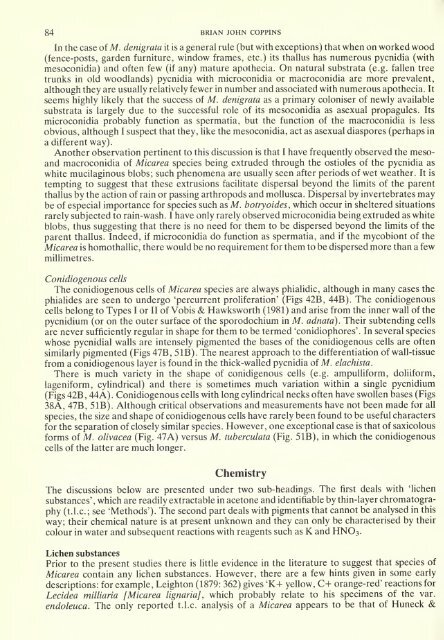Bulletin of the British Museum (Natural History)
Bulletin of the British Museum (Natural History)
Bulletin of the British Museum (Natural History)
You also want an ePaper? Increase the reach of your titles
YUMPU automatically turns print PDFs into web optimized ePapers that Google loves.
84<br />
BRIAN JOHN COPPINS<br />
In <strong>the</strong> case <strong>of</strong> M. denigrata it is a general rule (but with exceptions) that when on worked wood<br />
(fence-posts, garden furniture, window frames, etc.) its thallus has numerous pycnidia (with<br />
mesoconidia) and <strong>of</strong>ten few (if any) mature apo<strong>the</strong>cia. On natural substrata (e.g. fallen tree<br />
trunks in old woodlands) pycnidia with microconidia or macroconidia are more prevalent,<br />
although <strong>the</strong>y are usually relatively fewer in number and associated with numerous apo<strong>the</strong>cia. It<br />
seems highly likely that <strong>the</strong> success <strong>of</strong> M. denigrata as a primary coloniser <strong>of</strong> newly available<br />
substrata is largely due to <strong>the</strong> successful role <strong>of</strong> its mesoconidia as asexual propagules. Its<br />
microconidia probably function as spermatia, but <strong>the</strong> function <strong>of</strong> <strong>the</strong> macroconidia is less<br />
obvious, although I suspect that <strong>the</strong>y, like <strong>the</strong> mesoconidia, act as asexual diaspores (perhaps in<br />
a different way).<br />
Ano<strong>the</strong>r observation pertinent to this discussion is that I have frequently observed <strong>the</strong> mesoand<br />
macroconidia <strong>of</strong> Micarea species being extruded through <strong>the</strong> ostioles <strong>of</strong> <strong>the</strong> pycnidia as<br />
white mucilaginous blobs; such phenomena are usually seen after periods <strong>of</strong> wet wea<strong>the</strong>r. It is<br />
tempting to suggest that <strong>the</strong>se extrusions facilitate dispersal beyond <strong>the</strong> limits <strong>of</strong> <strong>the</strong> parent<br />
thallus by <strong>the</strong> action <strong>of</strong> rain or passing arthropods and mollusca. Dispersal by invertebrates may<br />
be <strong>of</strong> especial importance for species such as M. botryoides, which occur in sheltered situations<br />
rarely subjected to rain-wash. I have only rarely observed microconidia being extruded as white<br />
blobs, thus suggesting that <strong>the</strong>re is no need for <strong>the</strong>m to be dispersed beyond <strong>the</strong> limits <strong>of</strong> <strong>the</strong><br />
parent thallus. Indeed, if microconidia do function as spermatia, and if <strong>the</strong> mycobiont <strong>of</strong> <strong>the</strong><br />
Micarea is homothallic, <strong>the</strong>re would be no requirement for <strong>the</strong>m to be dispersed more than a few<br />
millimetres.<br />
Conidiogenous cells<br />
The conidiogenous cells <strong>of</strong> Micarea species are always phialidic, although in many cases <strong>the</strong><br />
phialides are seen to undergo 'percurrent proliferation' (Figs 42B, 44B). The conidiogenous<br />
cells belong to Types I or II <strong>of</strong> Vobis & Hawksworth (1981) and arise from <strong>the</strong> inner wall <strong>of</strong> <strong>the</strong><br />
pycnidium (or on <strong>the</strong> outer surface <strong>of</strong> <strong>the</strong> sporodochium in M. adnata). Their subtending cells<br />
are never sufficiently regular in shape for <strong>the</strong>m to be termed 'conidiophores'. In several species<br />
whose pycnidial walls are intensely pigmented <strong>the</strong> bases <strong>of</strong> <strong>the</strong> conidiogenous cells are <strong>of</strong>ten<br />
similarly pigmented (Figs 47B, 51B). The nearest approach to <strong>the</strong> differentiation <strong>of</strong> wall-tissue<br />
from a conidiogenous layer is found in <strong>the</strong> thick-walled pycnidia <strong>of</strong> M. elachista.<br />
There is much variety in <strong>the</strong> shape <strong>of</strong> conidigenous cells (e.g. ampuUiform, doliiform,<br />
lageniform, cyUndrical) and <strong>the</strong>re is sometimes much variation within a single pycnidium<br />
(Figs 42B, 44A). Conidiogenous cells with long cyhndrical necks <strong>of</strong>ten have swollen bases (Figs<br />
38A, 47B, 5 IB). Although critical observations and measurements have not been made for all<br />
species, <strong>the</strong> size and shape <strong>of</strong> conidiogenous cells have rarely been found to be useful characters<br />
for <strong>the</strong> separation <strong>of</strong> closely similar species. However, one exceptional case is that <strong>of</strong> saxicolous<br />
forms <strong>of</strong> M. olivacea (Fig. 47A) versus M. tuberculata (Fig. 5 IB), in which <strong>the</strong> conidiogenous<br />
cells <strong>of</strong> <strong>the</strong> latter are much longer.<br />
Chemistry<br />
The discussions below are presented under two sub-headings. The first deals with 'lichen<br />
substances', which are readily extractable in acetone and identifiable by thin-layer chromatography<br />
(t.l.c; see 'Methods'). The second part deals with pigments that cannot be analysed in this<br />
way; <strong>the</strong>ir chemical nature is at present unknown and <strong>the</strong>y can only be characterised by <strong>the</strong>ir<br />
colour in water and subsequent reactions with reagents such as K and HNO3.<br />
Lichen substances<br />
Prior to <strong>the</strong> present studies <strong>the</strong>re is little evidence in <strong>the</strong> literature to suggest that species <strong>of</strong><br />
Micarea contain any lichen substances. However, <strong>the</strong>re are a few hints given in some early<br />
descriptions: for example, Leighton (1879: 362) gives 'K+ yellow, C+ orange-red' reactions for<br />
Lecidea milliaria [Micarea lignaria], which probably relate to his specimens <strong>of</strong> <strong>the</strong> var.<br />
endoleuca. The only reported t.l.c. analysis <strong>of</strong> a Micarea appears to be that <strong>of</strong> Huneck &

















